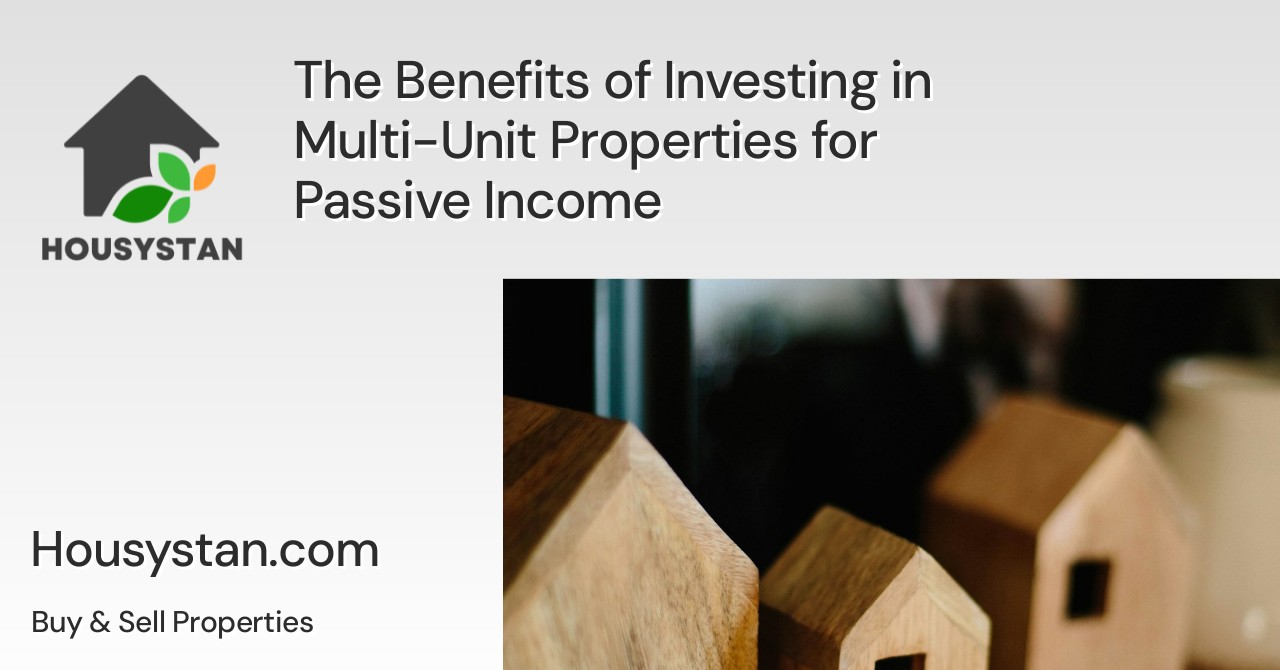The Benefits of Investing in Multi-Unit Properties for Passive Income
Read latest blogs and articles from Housystan

The Information mentioned here was last updated on:
11/12/2025The Benefits of Investing in Multi-Unit Properties for Passive Income
Investing in real estate is a tried-and-true strategy for building wealth, but navigating the different types of property investments can be daunting. Among these, multi-unit properties stand out as a compelling option, especially for those seeking a steady stream of passive income. Let's explore why investing in multi-unit properties can be a wise financial move and how it can lead to a stable revenue flow.
Understanding Multi-Unit Properties
- Verified Tenants/Buyers
- Unlimited Property Listing
- Zero subscription/charges fee
Before delving into the benefits, it's crucial to understand what multi-unit properties entail. These properties include duplexes, triplexes, and apartment buildings that house multiple families or tenants under one roof. They differ from single-family homes, which accommodate only one household. The beauty of multi-unit properties lies in their potential to generate income from various tenants, thereby spreading out the risk.
Steady Cash Flow
One of the most enticing benefits of owning multi-unit properties is the steady cash flow they provide. With multiple tenants paying rent, property owners often enjoy a more dependable income stream. Even if one unit is vacant temporarily, the income from other units can cover mortgage payments and other expenses, reducing the financial strain. This dynamic is especially appealing in comparison to single-family properties where vacancy can result in a complete halt of rental income.
Diversified Tenant Base
Having multiple tenants diversifies your income sources. Unlike single-family homes, where tenant turnover can result in zero rental income, multi-unit properties ensure you have multiple tenants contributing to your revenue. This diversification minimizes financial risk, ensuring that a vacancy in one unit doesn’t impact your overall financial stability dramatically. Additionally, with more tenants, you have opportunities for lease staggering, meaning tenants sign leases at different times, further stabilizing your income stream.
Economies of Scale
Multi-unit properties offer economies of scale that single-family homes cannot match. With more units under one property, expenses such as maintenance, repairs, and improvements can be distributed more efficiently. For instance, when upgrading the roofing of a multi-unit property, you're effectively covering several units with a single investment. This approach can lower the overall cost per unit, maximizing your return on investment.
Easier Property Management
Contrary to what some might expect, managing a multi-unit property can be more efficient than juggling multiple single-family homes. Many investors find it easier to hire a property management company for multi-unit buildings, as they provide comprehensive services that include tenant management, maintenance, and even financial management. This arrangement allows property owners to enjoy passive income without the hassle of day-to-day property concerns.
Appreciation and Inflation Hedge
Real estate, including multi-unit properties, is known for its potential to appreciate over time. As property values rise, so does your equity, simultaneously increasing your wealth. Additionally, rental income tends to adjust with inflation, meaning that as the cost of living rises, so can the rent you charge your tenants. This dynamic makes multi-unit properties a valuable hedge against inflation, preserving and potentially increasing your purchasing power.
Tax Benefits
Investing in real estate comes with various tax benefits, and multi-unit properties are no exception. Owners can deduct expenses such as property taxes, mortgage interest, property management fees, and even depreciation. Depreciation, in particular, is a significant advantage, as it allows investors to write off the cost of purchasing the property over a set period, reducing taxable income.
Ability to House Hack
House hacking is a strategy gaining popularity among new real estate investors. It involves living in one unit of a multi-unit property while renting out the others. This approach allows the owner to cover their mortgage and sometimes even generate extra income while enjoying the comfort of homeownership. It's an excellent entry point into real estate investing, as it provides first-hand experience with leasing and property management.
Lower Risk of Complete Income Loss
In the realm of real estate investment, risk management is essential. Multi-unit properties inherently offer a buffer against complete income loss. With multiple income streams from different tenants, the financial impact of a single vacancy or rent default is mitigated. This stability is comforting to investors, providing a more reliable path to financial security.
Building a Real Estate Portfolio
Multi-unit properties can be a cornerstone of a larger real estate investment portfolio. Once an investor becomes comfortable and familiar with managing a multi-unit property, the next logical step is often to scale up. Investing in additional multi-unit properties can lead to compounding income, increased equity, and greater financial independence.
Strategic Location Benefits
The location of a multi-unit property significantly influences its success as an investment. Properties in areas with high demand, such as urban centers or regions near universities and major employers, tend to attract more tenants. High occupancy rates lead to stable cash flows and allow for competitive rent pricing. By strategically choosing locations with appreciating real estate markets, investors can maximize their returns.
Financing Opportunities
While financing a multi-unit property may seem daunting, it often comes with unique benefits. Lenders recognize the income potential of these properties and may offer favorable terms. Additionally, government-insured loans, such as those from the Federal Housing Administration (FHA), cater to multi-unit properties, making it easier for investors—even those with moderate capital—to enter the market.
Growing Demand for Rentals
A persistent national trend is the growing demand for rental properties, a factor that bodes well for multi-unit property investors. With homeownership rates fluctuating and many individuals opting for the flexibility of renting, well-maintained multi-unit buildings often find it easier to secure tenants. This demand ensures a consistent occupancy rate, directly contributing to the stability of rental income.
Investing in multi-unit properties offers a compelling blend of financial benefits, risk management features, and growth opportunities. By understanding the dynamics of multi-unit investments, aspiring and seasoned investors alike can find a reliable path to passive income and long-term wealth.